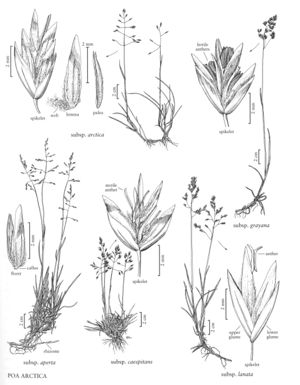Difference between revisions of "Poa arctica subsp. aperta"
FNA>Volume Importer |
imported>Volume Importer |
||
| (5 intermediate revisions by 2 users not shown) | |||
| Line 3: | Line 3: | ||
|accepted_authority=(Scribn. & Merr.) Soreng | |accepted_authority=(Scribn. & Merr.) Soreng | ||
|publications= | |publications= | ||
| + | |special_status={{Treatment/ID/Special_status | ||
| + | |code=E | ||
| + | |label=Endemic | ||
| + | }} | ||
|basionyms= | |basionyms= | ||
|synonyms={{Treatment/ID/Synonym | |synonyms={{Treatment/ID/Synonym | ||
|name=Poa aperta | |name=Poa aperta | ||
| − | |authority= | + | |authority= |
| + | |rank=species | ||
}} | }} | ||
|hierarchy=Poaceae;Poaceae subfam. Pooideae;Poaceae tribe Poeae;Poa;Poa subg. Poa;Poa sect. Poa;Poa arctica;Poa arctica subsp. aperta | |hierarchy=Poaceae;Poaceae subfam. Pooideae;Poaceae tribe Poeae;Poa;Poa subg. Poa;Poa sect. Poa;Poa arctica;Poa arctica subsp. aperta | ||
| Line 18: | Line 23: | ||
-->{{Treatment/Body | -->{{Treatment/Body | ||
| − | |discussion=<p><i>Poa arctica </i>subsp.<i> aperta</i> is restricted to subalpine and low alpine habitats on the Wasatch Escarpment and high mountains of the Colorado Plateau in southern Utah, and the Rocky Mountains of southern Colorado and northern New Mexico. Many reports of <i>P. arida</i> (p. 599) growing west of the Rocky Mountains are based on misidentification of this subspecies. <i>Poa arctica </i>subsp.<i> aperta</i> may reflect introgression of genes from <i>P. secunda</i> (p. 586) into <i>P. arctica</i>. It has softer leaves, and is more densely hairy between the lemma veins and the palea keels, than < | + | |discussion=<p><i>Poa arctica </i>subsp.<i> aperta</i> is restricted to subalpine and low alpine habitats on the Wasatch Escarpment and high mountains of the Colorado Plateau in southern Utah, and the Rocky Mountains of southern Colorado and northern New Mexico. Many reports of <i>P. arida</i> (p. 599) growing west of the Rocky Mountains are based on misidentification of this subspecies. <i>Poa arctica </i>subsp.<i> aperta</i> may reflect introgression of genes from <i>P. secunda</i> (p. 586) into <i>P. arctica</i>. It has softer leaves, and is more densely hairy between the lemma veins and the palea keels, than <i></i>subsp.<i> arctica</i>. It can be distinguished from <i></i>subsp.<i> grayana</i> by its more wiry culms, and less contracted panicles with straighter branches.</p> |
|tables= | |tables= | ||
|references= | |references= | ||
| Line 27: | Line 32: | ||
-->{{#Taxon: | -->{{#Taxon: | ||
name=Poa arctica subsp. aperta | name=Poa arctica subsp. aperta | ||
| − | |||
|authority=(Scribn. & Merr.) Soreng | |authority=(Scribn. & Merr.) Soreng | ||
|rank=subspecies | |rank=subspecies | ||
| Line 34: | Line 38: | ||
|basionyms= | |basionyms= | ||
|family=Poaceae | |family=Poaceae | ||
| + | |illustrator=Sandy Long | ||
| + | |illustration copyright=Utah State University | ||
|reference=None | |reference=None | ||
|publication title= | |publication title= | ||
|publication year= | |publication year= | ||
| − | |special status= | + | |special status=Endemic |
| − | |source xml=https:// | + | |source xml=https://bitbucket.org/aafc-mbb/fna-data-curation/src/200273ad09963decb8fc72550212de541d86569d/coarse_grained_fna_xml/V24/V24_743.xml |
|subfamily=Poaceae subfam. Pooideae | |subfamily=Poaceae subfam. Pooideae | ||
|tribe=Poaceae tribe Poeae | |tribe=Poaceae tribe Poeae | ||
Latest revision as of 17:25, 11 May 2021
Plants pale green, often glaucous; usually densely tufted, rhizomes usually short, usually well developed. Culms 20-60 cm, several together, wiry, bases decumbent. Sheaths closed for (1/6)1/5 – 1/3 their length; ligules 3-7 mm, sparsely to moderately scabrous, acute; blades 1.5-2.5 mm wide, flat, folded, or somewhat involute. Panicles 4-15 cm, erect, loosely contracted or open, with 1-3 branches per node; branches ascending or widely spreading, fairly stout, fairly straight, smooth to very sparsely scabrous, proximal branches 1/4-1/2 the panicle length. Spikelets narrowly lanceolate to lanceolate, not bulbiferous; florets 2-3(4), normal; rachilla internodes usually glabrous, infrequently sparsely softly puberulent; calluses glabrous or webbed, hairs to 1/4 the lemma length; lemmas 3-4.5(6) mm; palea keels usually softly puberulent to long-villous at midlength, infrequently glabrous, intercostal regions usually softly puberulent; anthers aborted late in development or fully developed. 2n = 98+1.
Discussion
Poa arctica subsp. aperta is restricted to subalpine and low alpine habitats on the Wasatch Escarpment and high mountains of the Colorado Plateau in southern Utah, and the Rocky Mountains of southern Colorado and northern New Mexico. Many reports of P. arida (p. 599) growing west of the Rocky Mountains are based on misidentification of this subspecies. Poa arctica subsp. aperta may reflect introgression of genes from P. secunda (p. 586) into P. arctica. It has softer leaves, and is more densely hairy between the lemma veins and the palea keels, than subsp. arctica. It can be distinguished from subsp. grayana by its more wiry culms, and less contracted panicles with straighter branches.
Selected References
None.
